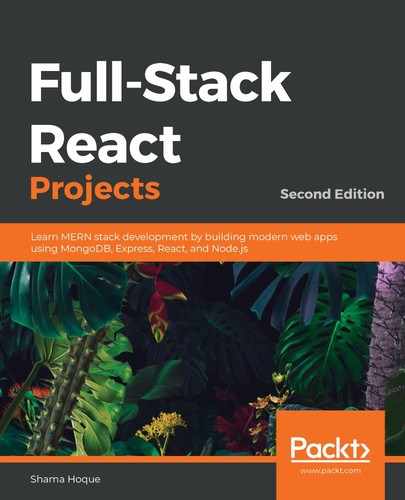Book Description
A practical, project-based guide to full-stack JavaScript web development combining the power of React with industry-tested server-side technologies
Key Features
- Build your career as a full-stack developer with this practical guide
- Understand how the different aspects of a MERN application come together through a series of practical projects
- Master the MERN stack by building robust social media, E-commerce store, and web-based VR game apps
Book Description
Facebook's React combined with industry-tested, server-side technologies, such as Node, Express, and MongoDB, enables you to develop and deploy robust real-world full-stack web apps. This updated second edition focuses on the latest versions and conventions of the technologies in this stack, along with their new features such as Hooks in React and async/await in JavaScript. The book also explores advanced topics such as implementing real-time bidding, a web-based classroom app, and data visualization in an expense tracking app.
Full-Stack React Projects will take you through the process of preparing the development environment for MERN stack-based web development, creating a basic skeleton app, and extending it to build six different web apps. You'll build apps for social media, classrooms, media streaming, online marketplaces with real-time bidding, and web-based games with virtual reality features. Throughout the book, you'll learn how MERN stack web development works, extend its capabilities for complex features, and gain actionable insights into creating MERN-based apps, along with exploring industry best practices to meet the ever-increasing demands of the real world.
By the end of this React book, you'll be able to build production-ready MERN full-stack apps using advanced tools and techniques in modern web development.
What you will learn
- Extend a basic MERN-based application to build a variety of applications
- Add real-time communication capabilities with Socket.IO
- Implement data visualization features for React applications using Victory
- Develop media streaming applications using MongoDB GridFS
- Improve SEO for your MERN apps by implementing server-side rendering with data
- Implement user authentication and authorization using JSON web tokens
- Set up and use React 360 to develop user interfaces with VR capabilities
- Make your MERN stack applications reliable and scalable with industry best practices
Who this book is for
This is one of the most useful web development books for JavaScript developers who may have worked with React but have minimal experience in full-stack development with Node, Express, and MongoDB.
Table of Contents
- Title Page
- Copyright and Credits
- Dedication
- About Packt
- Contributors
- Preface
- Getting Started with MERN
- Unleashing React Applications with MERN
- Preparing the Development Environment
- Selecting development tools
- Setting up MERN stack technologies
- Checking your development setup
- Summary
- Building MERN from the Ground Up
- Building a Backend with MongoDB, Express, and Node
- Adding a React Frontend to Complete MERN
- Defining the skeleton application frontend
- Setting up for React development
- Rendering a home page view 
- Integrating backend APIs
- Adding auth in the frontend
- Completing the User frontend 
- Implementing basic server-side rendering
- Summary
- Growing the Skeleton into a Social Media Application
- Introducing MERN Social
- Updating the user profile
- Following users in MERN Social
- Posting on MERN Social
- Interacting with Posts
- Summary
- Developing Web Applications with MERN
- Building a Web-Based Classroom Application
- Exercising MERN Skills with an Online Marketplace
- Introducing the MERN Marketplace app
- Allowing users to be sellers
- Adding shops to the marketplace
- Adding products to shops
- Searching for products with name and category
- Summary
- Extending the Marketplace for Orders and Payments
- Introducing cart, payments, and orders in the MERN Marketplace
- Implementing a shopping cart
- Using Stripe for payments
- Integrating the checkout process
- Creating a new order
- Listing orders by shop
- Viewing single-order details
- Summary
- Adding Real-Time Bidding Capabilities to the Marketplace
- Advancing to Complex MERN Applications
- Integrating Data Visualization with an Expense Tracking Application
- Building a Media Streaming Application
- Customizing the Media Player and Improving SEO
- Adding a custom media player to MERN Mediastream  
- Listing related media 
- The PlayMedia component
- Customizing the media player
- Autoplaying related media
- Server-side rendering with data
- Summary
- Developing a Web-Based VR Game
- Introducing the MERN VR Game
- Getting started with React 360
- Key concepts for developing the VR game
- Defining game details
- Building the game view in React 360
- Bundling for production and integration with MERN
- Summary
- Making the VR Game Dynamic using MERN
- Introducing the dynamic MERN VR Game application
- Defining a Game model
- Implementing game CRUD APIs
- Adding a form for creating and editing games
- Adding the game list views
- Playing the VR game
- Updating the game code in React 360
- Summary
- Going Forward with MERN
- Following Best Practices and Developing MERN Further
- Separation of concerns with modularity
- Adding CSS styles
- Selective server-side rendering with data
- Using stateful versus pure functional components
- Using Redux or Flux 
- Enhancing security
- Writing test code
- Optimizing the bundle size
- Extending the applications
- Summary
- Other Books You May Enjoy
